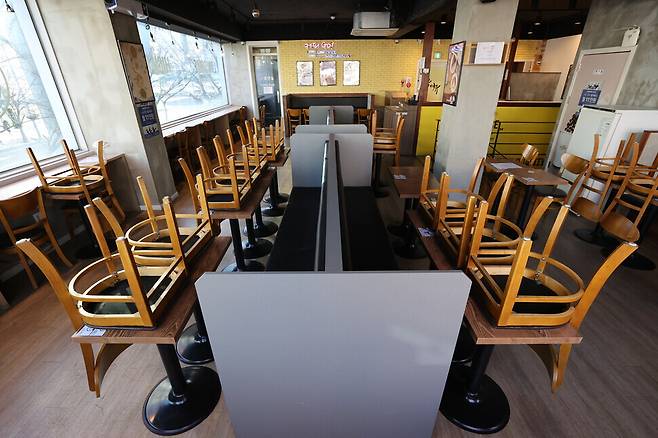[Reporter's notebook] Why a 3% growth rate projection isn't something to smile about
전체 맥락을 이해하기 위해서는 본문 보기를 권장합니다.
That seems like welcome news, but the reality is more complicated. The real economy has frozen to a deep chill. All around, stores are closing down, and employment opportunities are dwindling. Yet on the stock market, the KOSPI has surpassed 3,000 points, and people are talking about the "long-awaited 3,000+ era."
In a financial stability report last October, the International Monetary Fund (IMF) remarked on the gap between the real economy and market, explaining that the "US stock market is dominated by sectors and large firms that have been less affected by the pandemic than the broader economy."
이 글자크기로 변경됩니다.
(예시) 가장 빠른 뉴스가 있고 다양한 정보, 쌍방향 소통이 숨쉬는 다음뉴스를 만나보세요. 다음뉴스는 국내외 주요이슈와 실시간 속보, 문화생활 및 다양한 분야의 뉴스를 입체적으로 전달하고 있습니다.

Will 2021 see us through the end of the long COVID-19 tunnel? President Moon Jae-in said in his New Year’s address on Jan. 4 that we would “overcome the virus without fail and regain our precious daily lives.” That’s our one wish above all else: to be able to take these awful masks off when spring arrives.
Moon also said the new year would see South Korea “making the leap to become an advanced country.” Economic forecasts for the coming year — the South Korean government’s and those of economic institutes in South Korea and overseas — have been bright. They’re generally predicting the South Korean economy will grow by around 3% compared with last year.
That seems like welcome news, but the reality is more complicated. The real economy has frozen to a deep chill. All around, stores are closing down, and employment opportunities are dwindling. Yet on the stock market, the KOSPI has surpassed 3,000 points, and people are talking about the “long-awaited 3,000+ era.”
It’s one of those unfathomable polarization situations: the stock market is positively dripping with liquidity even as many people are struggling to put food on their table.
Perhaps we can talk about growth potential when we look at the country’s economy purely in terms of the numbers, but polarization is widening the chasm between job classes and economic classes. There’s been talk of a “K-shaped recovery” to describe the way the economy has bounced back amid the COVID-19 pandemic.
In terms of which sectors will show growth, semiconductor and IT firms are reportedly preparing for an era of services that do not involve physical contact. On the stock market, sectors called the “BBIG” industries — biotech, batteries, internet, and gaming — have been driving growth. Much of the new money going into the market has been channeled into these industries.
Industries that have suffered the most from the pandemic involve in-person contact: travel, food, hospitality, and leisure. This includes an especially large number of mom-and-pop shops; in most cases, they aren’t listed on the market. This has resulted in another form of polarization, where the ravages of the pandemic aren’t accurately reflected on the stock market.
In a financial stability report last October, the International Monetary Fund (IMF) remarked on the gap between the real economy and market, explaining that the “US stock market is dominated by sectors and large firms that have been less affected by the pandemic than the broader economy.”
Real estate has also been an inextricable part of this polarization. Amid soaring housing prices, consumers are scraping up every last cent to invest in property. The rising value of stocks and real estate has further enriched those with money, but people without enough to invest are left out in the cold. According to Statistics Korea, the top 10% of the population in terms of net assets accounted for 43.7% of all assets as of March 2020, an increase of 0.4 percentage points from the year before. If the COVID-19 pandemic continues through this year, this disparity could widen at an even faster rate.
A K-shaped recovery is a drag on the economy as a whole. As more and more businesses are driven to the brink of insolvency and as household debt surpasses GDP, we lose our ability to withstand external shocks. Suppose we actually end up with a growth rate of 3% or 4%. Can we really call ourselves an “advanced nation” without resolving this kind of polarization?
Untold impact of youth unemployment
The employment sector is in an even more serious state. The pandemic has already caused major job losses among women and young people, who chiefly work in service industries that involve face-to-face contact, and among gig workers, whose employment is relatively unstable. Once employment has fallen, it tends to take longer to bounce back than production or consumption. Even if sales recover, companies will be reluctant to hire new workers if they lack confidence in the future situation.
Among experts, the shared concern right now is a situation known as “hysteresis” that the younger generation could end up facing. Hysteresis is a phenomenon where the loss of career opportunities for young people translates into decreased employment and lower wages in the overall economy. A recent report published by the Korea Employment Information Service found a 5.9% decrease between May 2019 and May 2020 in the number of university graduates whose first job was a permanent position, and a 1.5% increase in those whose first job was a temporary gig position.
The economic impact of the younger generation’s missed career opportunities may not be evident right away. But if nothing is done about the situation, it will incur major losses to the national economy down the line.
The ruling Democratic Party has now started talking about a second round of disaster relief payments to the entire South Korean population. Such payments are a temporary solution, but they aren’t going to put a definitive end to polarization. It’s been a year already since the pandemic started. We can’t afford to let the debate on our response simply circle back to where it was when disaster relief payments were first discussed. It’s time for the “advanced country” debate to really begin.

By Lee Kyung-mi, staff reporter
Please direct comments or questions to [english@hani.co.kr]
Copyright © 한겨레. All rights reserved. 무단 전재, 재배포 및 크롤링 금지.
- [속보] 코로나19 신규 확진자 520명…지역 발생 500명
- ‘정인이들’ 위한 정치적 결단 해야 할 때다
- 번아웃, 남 인정 없이 못 사는 ‘비대한 공적 자아’의 최후
- 트럼프, 13번째 사형 집행…임기 종료 나흘 앞두고 밀어붙여
- 거리두기 31일까지 연장…학원·카페·헬스장 운영 재개
- ‘세수 오프닝’ 나경원, 딸과 탬버린 장단…정치의 예능화 ‘쓴맛’
- 당근마켓서 가장 많이 오간 선물은
- 카페 취식, 대면예배 제한적 허용…헬스장·노래방 문 연다
- 경기도, 전 도민에 10만원 재난기본소득…설명절 전 지급
- 드라마 ‘M’ 지금 봐도 무서운 초록 눈동자…“미쳤냐고 했죠, 하하”